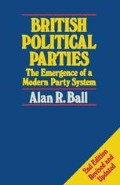Abstract
In 1945 the Labour Party, partly to its own surprise, achieved an over-all majority for the first time in its history. The new government had none of the limitations said to have shackled previous Labour governments, but it did not interpret the election results as a victory for ‘socialism’; the reforms of the Labour government were essentially uncontroversial and fully in keeping with the consensus that had emerged from the Second World War. The Bank of England, civil aviation, coal, gas, electricity, inland transport and iron and steel were nationalised, but only the nationalisation of iron and steel was controversial and only the last two were to be denationalised. Even the government was lukewarm over iron and steel, leaving it to the last; moreover, compensation was extremely generous for the previous owners of all these industries. The form of public ownership was quite comforting for those suspicious of Labour’s nationalisation programme; public boards or corporations, as favoured by the main architect, Herbert Morrison, ensured a degree of management continuity.
Preview
Unable to display preview. Download preview PDF.
Notes to Chapter 9
A. A. Rogow, The Labour Government and British Industry, 1945–51 (Oxford: Blackwell, 1955).
For an account of internal Labour politics between 1945 and 1951, see K. D. Morgan, Labour in Power (OUP, 1984) pp. 45–81.
Also H. Pelling, The Labour Governments 1945–51 (London: Macmillan, 1984).
L. Hunter, The Road to Brighton Pier (London: Arthur Barker, 1959) p. 32. The book is a fascinating mixture of gossip and political history.
See Hugh Dalton, High Tide and After, 1945–60 (London: Muller, 1962) p. 359.
See also M. Foot, Aneurin Bevan, 1945–60, vol. 2 (London: Davis Poynton, 1973) pp. 294–5, for the claim that health charges became ‘an obsession’ with Gaitskell.
Compare Foot’s account, very hostile to Gaitskell, with that of P. Williams, Hugh Gaitskell (London: Jonathan Cape, 1979), which is equally ungenerous to Bevan (see particularly pp. 238 and 267).
See Lord Moran, Churchill: The Struggle for Survival 1940–65 (London: Constable, 1966) p. 335.
See F. Williams, A Prime Minister Remembers (London: Heinemann, 1961) p. 91.
Also K. Harris, Attlee (London: Weidenfeld & Nicolson, 1982) pp. 258–61.
For an account of the plot, see B. Pimlott, Hugh Dalton (London: Jonathan Caope, 1985) pp. 505–8.
Also ‘his [Morrison’s] interpretation of the 1933 rules was open to question, while his personal interest in provoking a leadership contents was embarrassingly obvious to all’, B. Donoughue and G. W. Jones, Herbert Morrison (London: Weidenfeld & Nicolson, 1973) p. 343.
For a discussion of the Bevanites, see M. Jenkins, Bevanism: Labour’s High Tide (Nottingham: Spokesman, 1979). The book has a particular concern with Eastern Europe but chs 5–6 are relevant here.
R. Miliband, Parliamentary Socialism, 2nd edn (London: Merlin Press, 1972) p. 322.
R. H. S. Crossman (ed.), New Fabian Essays (London: Turnstile, 1952); and
C. A. R. Crosland, The Future of Socialism (London: Jonathan Gape, 1956).
For details on Socialist Commentary and Socialist Union see S. Haseler, The Gaitskellites (London: Macmillan, 1969) pp. 66–80.
D. E Butler and R. Rose, The British General Election of 1959 (London: Cass, 1970) p. 15.
In M. Abrams and R. Rose, Must Labour Lose? (Harmondsworth: Penguin, 1960) p. 105.
See L. Minkin, The Labour Party Conference, rev. edn (Manchester University Press, 1980) pp. 369–73. It is difficult, therefore, to give exact figures.
M. Harrison, The Trade Unions and the Labour Party Since 1945 (London: Allen & Unwin, 1960) p. 316.
Also K. Hindell and P. Williams, ‘Scarborough and Blackpool: An Analysis of Some Votes and the Labour Party Conferences of 1960 and 1961’, Political Quarterly, vol. XXXIII, no. 3, July–September 1962, pp. 306–20.
Compare Crosland, p. 341, with the views of an American conservative-pluralist, S. M. Lipset, Political Man (New York: Anchor, 1963) pp. 227–9.
See R. T. McKenzie, ‘The Wilson Report and the Future of the Labour Party Organisation’, Political Studies, vol. 4, no. 1, February 1956, pp. 93–7.
Author information
Authors and Affiliations
Copyright information
© 1987 Alan R. Ball
About this chapter
Cite this chapter
Ball, A.R. (1987). The Labour Party, 1945–64. In: British Political Parties. Palgrave, London. https://doi.org/10.1007/978-1-349-18725-6_11
Download citation
DOI: https://doi.org/10.1007/978-1-349-18725-6_11
Publisher Name: Palgrave, London
Print ISBN: 978-0-333-44502-0
Online ISBN: 978-1-349-18725-6
eBook Packages: Palgrave Political & Intern. Studies CollectionPolitical Science and International Studies (R0)

